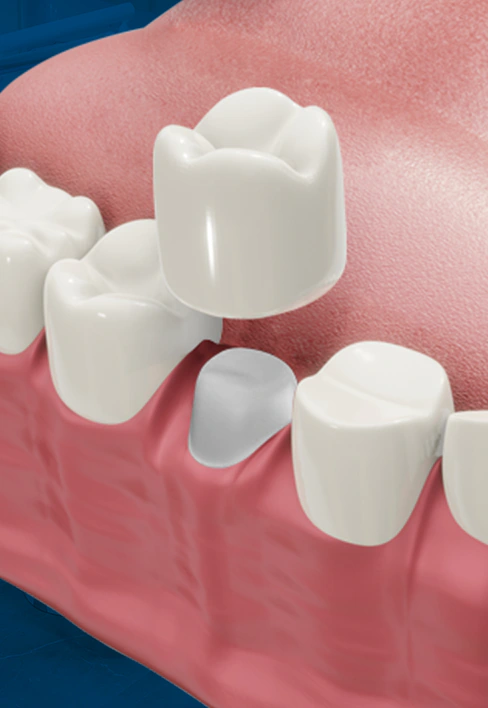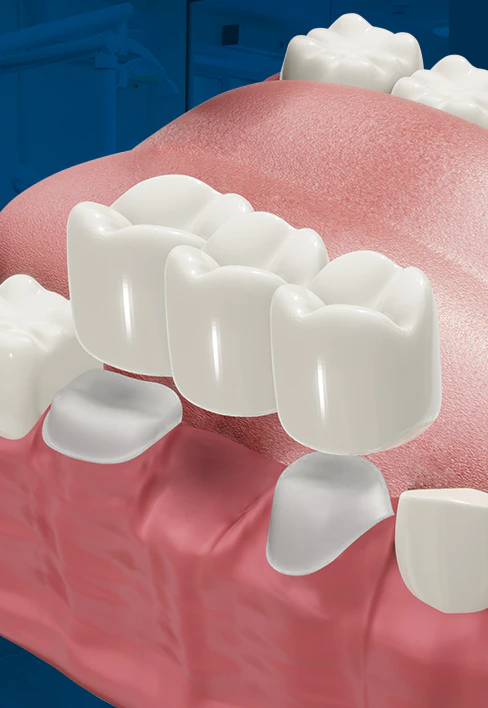Dental Crowns & Bridges
Dental Crowns
Crowns are dental restorations that completely cover a tooth to improve its strength, shape or appearance. Crowns are most often used for teeth that are broken, worn, or partially destroyed by tooth decay. Crowns can also be used to esthetically improve the appearance of a patients smile when other dental restorative procedures cannot.

Dental Bridges
Dental bridges are similar to crowns as they completely cover teeth, but differ in that they use a number of crowns to bridge the gap created by one or more missing teeth. Dental bridges are a fantastic way to replace missing teeth as they can be very esthetic while keeping your smile functioning normally.


What Is a Dental Crown?
A dental crown is a “cap” that covers your entire tooth. Crowns are most often used to help strengthen a tooth when there is insufficient tooth structure remaining to hold a filling. Crowns can also be used to protect weak teeth from breaking, protect a root canal treated tooth, restore dental implants, or restore an already broken/damaged tooth. Your dentist may also recommend dental crowns as a way to hide teeth that are discolored or misshapen.
Crowns are typically made from porcelain, ceramic or some type of resin—though they can also be made from gold alloy. Tooth colored materials like porcelain or ceramic are most often preferred because they mimic the translucency of natural teeth and are very strong.
What Is the Dental Crown Procedure?
Dental crowns are usually a multi-appointment procedure.
A crucial first step is choosing the correct shade for the final crown. It is best done at the beginning of the appointment to ensure the most accurate color is selected. This gives patients the most natural result.
01
The tooth will then be prepared and shaped – any decay or previous filling material will be removed. If necessary, a filling will be placed and contoured to ensure the tooth is the proper shape.
02
Then an impression is taken to capture the exact shape of the tooth and its relation to the adjacent teeth. A temporary crown will be made to cover and protect the tooth until your final crown is ready.
03
The final crown is created in a dental laboratory from the impression (described above) which allows a dental lab technician to examine all aspects of your bite and jaw movements. The crown will be custom-made for your mouth taking into account these movements and also fulfill the necessary esthetics.
04
At the second appointment, the temporary will be removed and the fit of the permanent crown will be checked. It is important to make sure that it fits well and is adapted accurately to the tooth. Once this is confirmed, the crown will be permanently cemented or bonded into place.
05

What Is a Dental Bridge?
Also known as a fixed partial denture, dental bridges are used to literally bridge the gap created by one or more missing teeth. A typical dental bridge is comprised of one or more pontic (artificial) teeth that are held in place by two dental crowns. Dental bridges are a fantastic way to replace missing teeth as they can be very esthetic while keeping your smile functioning normally.
What Is the Dental Bridge Procedure?
The bridge procedure is very similar to the crown procedure listed above.
The only significant difference is that during a bridge procedure, multiple teeth are prepared and shaped.
Your dentist will begin by preparing and shaping the teeth on either side of the missing tooth/teeth area. Then, an impression is taken of the treatment area. Finally, either a temporary bridge or multiple crowns are made to protect the teeth until the final permanent bridge is ready.
01
Once the permanent bridge comes back from the lab, the steps for delivering the bridge are also similar to the crown. The temporary crowns/bridge are then removed and the final bridge is tried in. It is important to make sure the bridge fits and functions properly. Once confirmed, the bridge is permanently cemented or bonded into place.
02
How Long Will
A Dental Crown or Dental Bridge Last?
With proper care, your beautiful smile can last a lifetime. Maintaining proper oral health is key to the long term success of restored teeth. It is important to brush and floss everyday and to see your dentist regularly.


Why Replace Missing Teeth
With Dental Crowns or Bridges?
Teeth play a key role in keeping your mouth functioning properly. After a tooth is lost or removed chewing function can decline. Depending on the location of the lost tooth, the surrounding teeth can shift. When this happens, changes in the bite can adversely affect the chewing ability. Also, tipped or shifted teeth are more prone to developing gum disease.
Replacing missing teeth minimizes these problems. Unlike removable appliances such as partials or dentures, crowns and bridges are cemented in place. Once they are properly fitted, they act and feel like the natural tooth that was lost.
Come to Sodini Dental for
Dental Crowns in Skokie, Il
If you are interested in seeing if you are a candidate for porcelain dental crowns or bridges, please don’t hesitate to reach out to our Skokie, IL dental office! Our dentists have over 30 years of experience. We would be happy to answer your questions and schedule a consultation to learn more about your smile.

